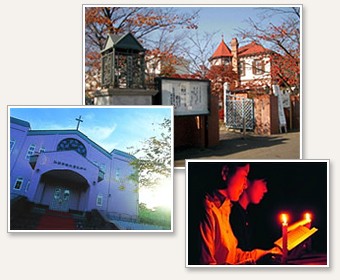
Introduction
Introduction to Hirosaki Gakuin University
Hirosaki Gakuin University opened in 1886 as the first general education school for females in Aomori prefecture.
The Tsugaru clan of Hirosaki supported Mr. Yoichi Honda's pioneering doctrine of Christian education for the nation.
Currently, a junior high school, high school, university, and a graduate school comprise the educational organization.
Hirosaki Gakuin University, founded in the spirit of “Honoring God, Loving People,” opened as a junior college in 1950. In 1971, a four-year School of Liberal Arts was established; followed by the opening of the School of Social Welfare in 1999 and the School of Nursing in 2005. In 2003, the Graduate School of Social Welfare was opened, followed by the Graduate School of Liberal Arts in 2005.
The university is now comprised of three undergraduate schools encompassing four departments and two graduate programs.

Undergraduate Schools / Graduate Schools
Undergraduate Schools
- School of Liberal Arts English / English Literature Dept.
- The English Language - English Literature Departments have “English Language,” “English Literature” and “Western Culture” majors. “English Language” majors study scientific analysis of the language, its sounds, and theories about their meanings. “English and American Literature” majors study British and American literature from Shakespeare and the Bible to modern literary works; “Western Culture” majors learn intercultural communication and cultural comparison of Japanese and Western cultures, traditions, and customs.
- School of Liberal Arts Japanese / Japanese Literature Dept.
- In the Japanese Language and Literature Department, you can study a wide range of literature from classic to contemporary, the structure of the Japanese language, of course, history, and also the so-called "sub-culture" of manga and anime. As true international humans, you will study various points of view about the culture of Japan, which continues to influence the world. In addition, you can take courses that discuss Osamu Dazai and Shuji Terayama, independent writers with a connection to Aomori Prefecture.
- School of Social Welfare Social Welfare Dept.
- In the Social Welfare Department, the goal of instruction is “the creation of a welfare society alive with rich thinking minds” with a sense of knowledge and technology as a professional goal. Therefore, the first through fourth years include practical courses and the second through fourth years have a systemic practical training program. In order to explore the transformation of society, students’ ability to maintain a global perspective will be nurtured.
- School of Nursing Nursing Dept.
- In the Department of Nursing, registered nurses prepare aspirants to the public health nurse qualification to study in the professional academic programs by instructing “core courses,” and “foundation courses” in anatomy, disease, etc. Students learn the meaning and essence of care and providing assistance through “practical courses” in which students integrate their knowledge and skills in the real-life situations of nursing hospitals and welfare facilities, thereby increasing their professional expertise. By passing these three course types, students will gain the necessary qualities to qualify as a registered nurse or public health nurse.
Graduate Schools
- Graduate School of Liberal Arts Dept. of Japanese Literature
- Through the study of northern Tohoku literature and culture, the program aims to nourish the advanced professional competence, and to develop human resources to contribute to the activation of the society through the study of Japanese literature and the Japanese spirit.
- Graduate School of Social Welfare Dept. of Human and Social Welfare
- Rooted in the aim of the systematization of human sociology, anthropology, spiritual background and evangelical Christianity in the region, is a graduate program studying a distinctive welfare system that is open to society.